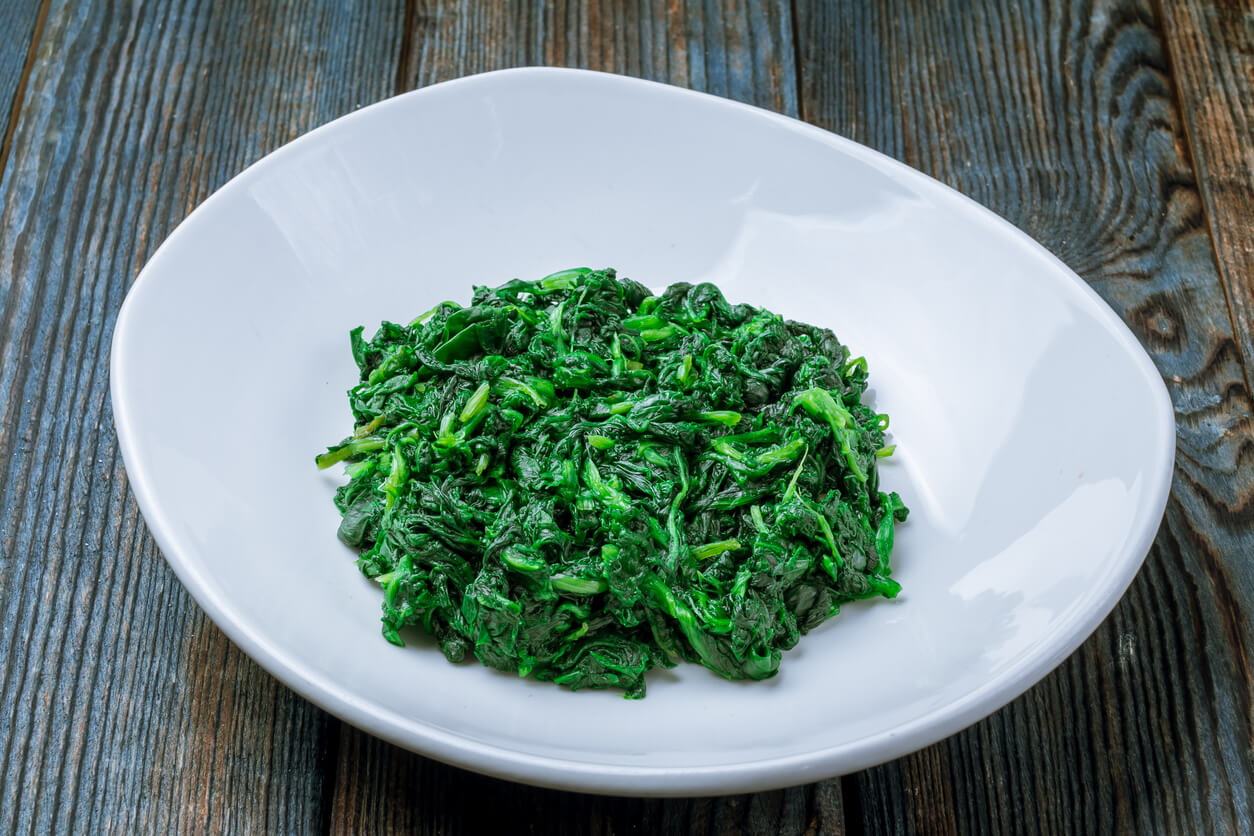The Importance of Broccoli, Cauliflower and Spinach for Children

The intake of vegetables at an early age can contribute to balance in the child’s diet. It’s best to start introducing them when children are babies in order to modify their eating habits. Broccoli, cauliflower, and spinach are among the most nutritious vegetables, but the hardest to accept due to their strong smells and flavors. Why are they so necessary in your children’s diet? We’ll explain the answer in this article.
Learn why you should include broccoli, cauliflower, and spinach in your children’s menu
Vegetables belong to the group of foods that balance the diet. They’re a vehicle for a variety of vitamins, minerals, and other bioactive compounds that are not found in foods of animal origin. Broccoli, cauliflower, and spinach are examples of 3 star vegetables that complement children’s diets.
1. Broccoli
Broccoli is a green, edible flower that belongs to the Brassicaceae family. Although it has a water content of almost 90 %, the remaining 10 % is made up of nutrients of high value for the growth and development of children. The Spanish Nutrition Foundation describes it as a vegetable with a good value of insoluble dietary fiber, which helps prevent constipation.
At the same time, according to the USDA nutritional table, one serving of broccoli contains between 80 to 100 milligrams of the antioxidant vitamin C, which more than doubles the requirements of children up to 13 years of age. However, it should be cooked at low temperatures and for a short time to avoid the destruction of this vitamin. In addition, it provides between 25 to 30% of what’s required by children from 1 to 6 years old and 15% for older children.
Broccoli also stands out as a source of folate, with about 65 micrograms of this nutrient per 100 grams of the vegetable. This represents between 15 to 20% of what a child between 1 and 8 years of age requires. This vitamin helps form red blood cells and prevent anemia. A paper published in Foods and Science Reports highlights that broccoli is an excellent source of phytochemicals, such as glucosinolates, phenolics, and other bioactives, with positive effects on health.
Cauliflower

Cauliflower, like broccoli, is an edible flower belonging to the same Brasicáceae family. It’s white in color, although there are yellow and red varieties as well. It’s also related to cabbages and kohlrabi. A characteristic feature is its strong odor and the production of gas when the baby’s digestive system is still immature. Therefore, it’s best to introduce it in small portions to test if it’s well tolerated.
When a child consumes 100 grams of cauliflower, they actually ingest 92 grams of water. Among its nutrients, it contains 2 grams of insoluble fiber, such as cellulose and hemicellulose, which improve and regulate intestinal transit. In addition, it contains 70 micrograms of folates. When compared with the recommendations of the Spanish Association of Pediatrics, it manages to cover between 20 and 50% of the requirements for children between 1 and 13 years old.
At the same time, vitamin C is also significant in cauliflower, as the 67 milligrams of vitamin C found in 100 grams of cauliflower exceed the requirements for children. The magazine Food Science and Technology explains that microwave cooking retains more vitamin C than when the food is boiled.
Spinach
Spinach is a green leafy vegetable that has been identified for its iron supply for children. However, there are other nutrients of value to consider. Like other leafy greens, its major contribution is water, at almost 90%. It also contains considerable amounts of protein, with a contribution of 2.6 grams per 100 grams of food. It’s also a good source of insoluble fiber, with 6%, which helps prevent constipation.
The Spanish Nutrition Foundation mentions that a 100-gram serving of spinach provides about 4 milligrams of iron, but it’s not fully absorbable. At the same time, potassium, calcium, magnesium, and phosphorus are other minerals that stand out, but like iron, they can be trapped by fiber, phytic acid, or oxalate, which prevent their absorption.
Vitamins that predominate in spinach
- Folates: Spinach covers 93% of what a child between 1 and 3 years old needs and 70% for children between 4 and 8 years old. This vitamin helps to form blood cells and prevents anemia.
- Vitamin A: The contribution is 542 micrograms of retinol per 100 grams of spinach. It helps with growth, the increase of the body’s defenses, and visual health.
- Beta-carotenes: These are a group of pigments that have the capacity to transform into vitamin A.
- Other carotenoids: Spinach provides 4230 micrograms of lutein and 377 micrograms of zeaxanthin, which are part of the crystalline lens and retina of the eye. These prevent blindness in advanced ages, as explained in the journal Hospital Nutrition.
- Vitamin C: The 30 milligrams of ascorbic acid in spinach help fight infections and form collagen that benefits children’s growth. However, according to the USDA, 65% is lost with boiling, as values drop to 9.8 milligrams per percent.
- Phenolic compounds: These are responsible for very efficiently capturing free radicals that cause damage at the cellular level. The details of their antioxidant function are explained in the report of the Institute for Crop & Food Research of New Zealand.
- Vitamin K: According to the USDA nutritional table, spinach provides 494 micrograms per 100-gram serving. It supports blood clotting and bone health.

Some precautions for the consumption of broccoli, cauliflower, and spinach
Broccoli, cauliflower, and spinach contain oxalates, a kind of natural salts in vegetables that can bind with minerals and form kidney stones. At the same time, cauliflower can cause gas in babies, so it’s best to start with small portions. If it’s not tolerated, it’s best to wait until after one year of age to incorporate it into your little one’s menu.
Spinach should also be used with caution, as it provides nitrates, substances with certain effects on the blood. A study published in the journal Pediatrics and Primary Care reveals that its high consumption may represent a risk for children under 3 years of age. The health problem is known as infant methemoglobinemia or blue baby syndrome, which results in less oxygen reaching the cells.
What portions to use and how to prepare them?
- For children between 12 months and 5 years, you can give 1 plate of cauliflower or broccoli and 1/2 cup of spinach.
- These vegetables are indicated from the age of 6 months if the baby tolerates them well.
- They should be steamed without causing them to become too soft.
- Overcooking destroys vitamins and minerals.
- It’s not advisable to add salt until after one year of age, but olive oil can be added.
- Keep them frozen if case you don’t use them all at once.
Is the consumption of broccoli, cauliflower, and spinach recommended for children?
The answer is a resounding yes. These vegetables provide essential vitamins for children’s growth and in order to maintain their health. For example, vitamin A, folic acid, vitamin C, and vitamin K. They also provide minerals and bioactive compounds to combat possible current diseases or prevent them in the long term. Take advantage of broccoli, cauliflower, and spinach, and activate your imagination with a variety of preparations!
The intake of vegetables at an early age can contribute to balance in the child’s diet. It’s best to start introducing them when children are babies in order to modify their eating habits. Broccoli, cauliflower, and spinach are among the most nutritious vegetables, but the hardest to accept due to their strong smells and flavors. Why are they so necessary in your children’s diet? We’ll explain the answer in this article.
Learn why you should include broccoli, cauliflower, and spinach in your children’s menu
Vegetables belong to the group of foods that balance the diet. They’re a vehicle for a variety of vitamins, minerals, and other bioactive compounds that are not found in foods of animal origin. Broccoli, cauliflower, and spinach are examples of 3 star vegetables that complement children’s diets.
1. Broccoli
Broccoli is a green, edible flower that belongs to the Brassicaceae family. Although it has a water content of almost 90 %, the remaining 10 % is made up of nutrients of high value for the growth and development of children. The Spanish Nutrition Foundation describes it as a vegetable with a good value of insoluble dietary fiber, which helps prevent constipation.
At the same time, according to the USDA nutritional table, one serving of broccoli contains between 80 to 100 milligrams of the antioxidant vitamin C, which more than doubles the requirements of children up to 13 years of age. However, it should be cooked at low temperatures and for a short time to avoid the destruction of this vitamin. In addition, it provides between 25 to 30% of what’s required by children from 1 to 6 years old and 15% for older children.
Broccoli also stands out as a source of folate, with about 65 micrograms of this nutrient per 100 grams of the vegetable. This represents between 15 to 20% of what a child between 1 and 8 years of age requires. This vitamin helps form red blood cells and prevent anemia. A paper published in Foods and Science Reports highlights that broccoli is an excellent source of phytochemicals, such as glucosinolates, phenolics, and other bioactives, with positive effects on health.
Cauliflower

Cauliflower, like broccoli, is an edible flower belonging to the same Brasicáceae family. It’s white in color, although there are yellow and red varieties as well. It’s also related to cabbages and kohlrabi. A characteristic feature is its strong odor and the production of gas when the baby’s digestive system is still immature. Therefore, it’s best to introduce it in small portions to test if it’s well tolerated.
When a child consumes 100 grams of cauliflower, they actually ingest 92 grams of water. Among its nutrients, it contains 2 grams of insoluble fiber, such as cellulose and hemicellulose, which improve and regulate intestinal transit. In addition, it contains 70 micrograms of folates. When compared with the recommendations of the Spanish Association of Pediatrics, it manages to cover between 20 and 50% of the requirements for children between 1 and 13 years old.
At the same time, vitamin C is also significant in cauliflower, as the 67 milligrams of vitamin C found in 100 grams of cauliflower exceed the requirements for children. The magazine Food Science and Technology explains that microwave cooking retains more vitamin C than when the food is boiled.
Spinach
Spinach is a green leafy vegetable that has been identified for its iron supply for children. However, there are other nutrients of value to consider. Like other leafy greens, its major contribution is water, at almost 90%. It also contains considerable amounts of protein, with a contribution of 2.6 grams per 100 grams of food. It’s also a good source of insoluble fiber, with 6%, which helps prevent constipation.
The Spanish Nutrition Foundation mentions that a 100-gram serving of spinach provides about 4 milligrams of iron, but it’s not fully absorbable. At the same time, potassium, calcium, magnesium, and phosphorus are other minerals that stand out, but like iron, they can be trapped by fiber, phytic acid, or oxalate, which prevent their absorption.
Vitamins that predominate in spinach
- Folates: Spinach covers 93% of what a child between 1 and 3 years old needs and 70% for children between 4 and 8 years old. This vitamin helps to form blood cells and prevents anemia.
- Vitamin A: The contribution is 542 micrograms of retinol per 100 grams of spinach. It helps with growth, the increase of the body’s defenses, and visual health.
- Beta-carotenes: These are a group of pigments that have the capacity to transform into vitamin A.
- Other carotenoids: Spinach provides 4230 micrograms of lutein and 377 micrograms of zeaxanthin, which are part of the crystalline lens and retina of the eye. These prevent blindness in advanced ages, as explained in the journal Hospital Nutrition.
- Vitamin C: The 30 milligrams of ascorbic acid in spinach help fight infections and form collagen that benefits children’s growth. However, according to the USDA, 65% is lost with boiling, as values drop to 9.8 milligrams per percent.
- Phenolic compounds: These are responsible for very efficiently capturing free radicals that cause damage at the cellular level. The details of their antioxidant function are explained in the report of the Institute for Crop & Food Research of New Zealand.
- Vitamin K: According to the USDA nutritional table, spinach provides 494 micrograms per 100-gram serving. It supports blood clotting and bone health.

Some precautions for the consumption of broccoli, cauliflower, and spinach
Broccoli, cauliflower, and spinach contain oxalates, a kind of natural salts in vegetables that can bind with minerals and form kidney stones. At the same time, cauliflower can cause gas in babies, so it’s best to start with small portions. If it’s not tolerated, it’s best to wait until after one year of age to incorporate it into your little one’s menu.
Spinach should also be used with caution, as it provides nitrates, substances with certain effects on the blood. A study published in the journal Pediatrics and Primary Care reveals that its high consumption may represent a risk for children under 3 years of age. The health problem is known as infant methemoglobinemia or blue baby syndrome, which results in less oxygen reaching the cells.
What portions to use and how to prepare them?
- For children between 12 months and 5 years, you can give 1 plate of cauliflower or broccoli and 1/2 cup of spinach.
- These vegetables are indicated from the age of 6 months if the baby tolerates them well.
- They should be steamed without causing them to become too soft.
- Overcooking destroys vitamins and minerals.
- It’s not advisable to add salt until after one year of age, but olive oil can be added.
- Keep them frozen if case you don’t use them all at once.
Is the consumption of broccoli, cauliflower, and spinach recommended for children?
The answer is a resounding yes. These vegetables provide essential vitamins for children’s growth and in order to maintain their health. For example, vitamin A, folic acid, vitamin C, and vitamin K. They also provide minerals and bioactive compounds to combat possible current diseases or prevent them in the long term. Take advantage of broccoli, cauliflower, and spinach, and activate your imagination with a variety of preparations!
All cited sources were thoroughly reviewed by our team to ensure their quality, reliability, currency, and validity. The bibliography of this article was considered reliable and of academic or scientific accuracy.
- Asociación Española de Pediatría. Ácido fólico. Disponible en: https://www.aeped.es/comite-medicamentos/pediamecum/acido-folico
- Basulto, J; Manera, M; Baladia, E. (2014). Ingesta dietética de nitratos en bebés y niños españoles y riesgo de metahemoglobinemia. Pediatr. aten. prim ; 16(61): 65-69. Disponible en: http://scielo.isciii.es/scielo.php?script=sci_arttext&pid=S1139-76322014000100013
- Fernández-Araque, Ana, Giaquinta-Aranda, Andrea, Laudo-Pardos, Consuelo, & Rojo-Aragüés, Abel-A.. (2017). Los antioxidantes en el proceso de patologías oculares. Nutrición Hospitalaria, 34(2), 469-478. https://dx.doi.org/10.20960/nh.420
- Fundación Española de Nutrición. Brécol. Disponible en: https://www.fen.org.es/MercadoAlimentosFEN/pdfs/brecol.pdf
- Hedges, L & Lister, Carolyn. (2007). Nutritional attributes of spinach, silver beet and eggplant. Disponible en: https://www.researchgate.net/publication/268516190_Nutritional_attributes_of_spinach_silver_beet_and_eggplant/citation/downloadle
- Lee S, Choi Y, Jeong HS, Lee J, Sung J. (2018). Effect of different cooking methods on the content of vitamins and true retention in selected vegetables. Food Sci Biotechnol; 27(2): 333-342
- Lee, S., Choi, Y., Jeong, H. S., Lee, J., & Sung, J. (2017). Effect of different cooking methods on the content of vitamins and true retention in selected vegetables. Food science and biotechnology, 27(2), 333–342. https://doi.org/10.1007/s10068-017-0281-1
- National Institutes of Health. NIH. Vitamina C. Disponible en: https://ods.od.nih.gov/factsheets/VitaminC-DatosEnEspanol/
- Shubha, Kumari & Reetu, Dr & Anand, Shreya & Mukherjee, Anirban. (2020). Broccoli a potential functional food. 10.13140/RG.2.2.19222.57927.
- U.S. Departament of Agriculture. Spinach, cooked, boiled, drained, whithout salt. Disponible en: https://fdc.nal.usda.gov/fdc-app.html#/food-details/168463/nutrients
This text is provided for informational purposes only and does not replace consultation with a professional. If in doubt, consult your specialist.








